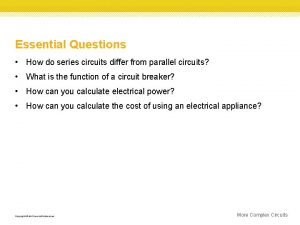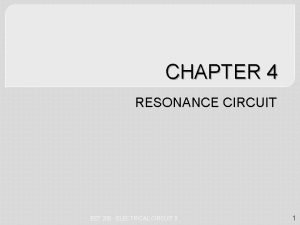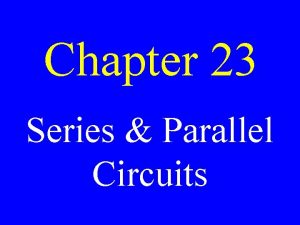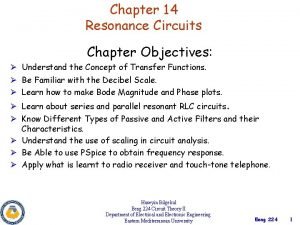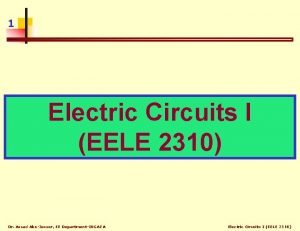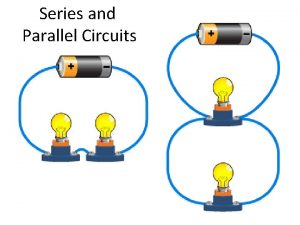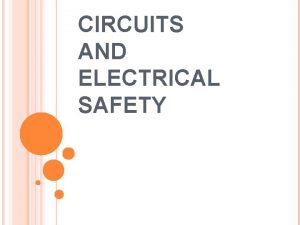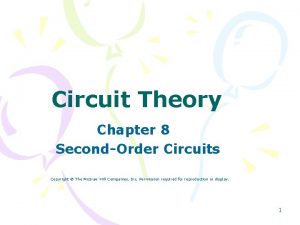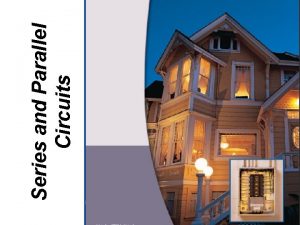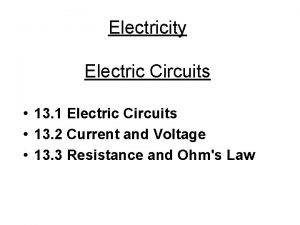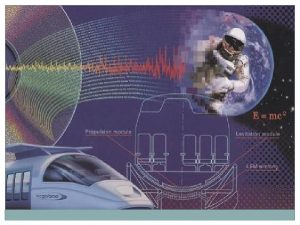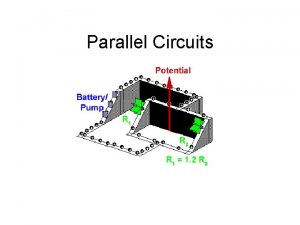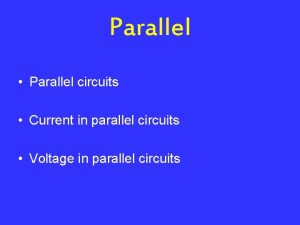Electric Circuits Series and Parallel Circuits Making Electricity












- Slides: 12

Electric Circuits Series and Parallel Circuits Making Electricity Work for Us

Requirements for a Circuit • Electric Potential Source – battery – power supply – electrical outlet • Load – resistor – light bulb – appliances • Conductors – wires to connect – switches + -

Measuring Voltage and Current • Voltmeter – measures voltage – voltage across – wired in parallel • Ammeter – measures current – current through – wired in series V + + A - -

Series Circuit R 1 R 2 + R 3 V -

Simple Series Circuit • Current has only one way to go through the resistors. • The current through each resistor is the same. • To get the total (or equivalent) resistance, add up the resistance of all the resistors. • The current of the circuit is equal to the supply voltage divided by the total resistance.

Series (continued) • The voltage drop across each resistor is equal to the current times the resistance (V = IR). • The total voltage drop across the resistors is equal to the voltage provided by the supply. • RTOT = R 1 +R 2 +R 3 + …… + RN

Parallel Circuit + V R 1 - R 2 R 3

Parallel Circuit • The voltage is the same across each resistor. • The current splits between resistors. The current will like the easiest path (the least resistance), so there will be more current in the path of the smallest resistor. • The total current in the circuit equals the sum of the currents in the branches. • As the number of parallel branches increases, the overall resistance decreases.

Parallel (continued) • The equivalent resistance of two identical resistors in parallel is one half the value of the individual resistors. • For two resistors that are not the same, • For more than two resistors,

Complex Circuit R 1 R 3 + R 2 V - R 4

Simplifying Complex Circuits • 1. Find the parts of the circuit where resistors are simply in parallel or simply in series. In the circuit above, R 3 and R 4 are simply in series. There are no resistors simply in parallel. • 2. If two or more resistors are in series, combine them in an equivalent resistance. • 3. If two or more resistors are in parallel, combine them in an equivalent resistance. • 4. Repeat steps 1 and 2 until the circuit has been simplified into a single resistance. • 5. Determine the current of the simplest circuit. • 6. Work back out, calculating the voltage across each resistor the current through each resistor using Ohm’s Law.

Overloading Circuits • Overloaded Circuit – Wires connected in a short circuit – Too many devices in parallel • Current becomes too high – wires become too hot – fire danger • Protection shuts off the power – fuse burns out – circuit breaker opens
 Series parallel circuit current
Series parallel circuit current Pros and cons of parallel and series circuits
Pros and cons of parallel and series circuits Difference between series and parallel circuit
Difference between series and parallel circuit How do series and parallel circuits differ
How do series and parallel circuits differ Series and parallel circuits
Series and parallel circuits Chapter 23 series and parallel circuits
Chapter 23 series and parallel circuits Series and parallel circuits
Series and parallel circuits Lesson 8: comparing series and parallel rlc circuits
Lesson 8: comparing series and parallel rlc circuits Facts about series circuits
Facts about series circuits Bill nye current electricity
Bill nye current electricity Venn diagram of series circuit and parallel circuit
Venn diagram of series circuit and parallel circuit Every circuit must have
Every circuit must have Lesson 8: comparing series and parallel rlc circuits
Lesson 8: comparing series and parallel rlc circuits



